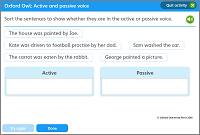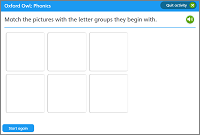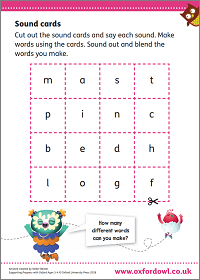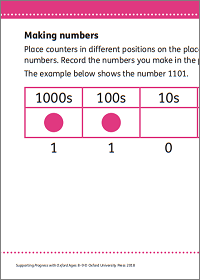Jargon buster: 'Partitioning' to 'punctuation'

A | B–C | D–G | H–L | M | N–O | P | Q–R | S | T–Z
A | B | C | D | E | F | G | H | I | J | K | L | M | N | O | P | Q | R | S | T | U | V | W | X | Y | Z
P
Paragraph
A group of linked sentences that are usually about the same thing. A new paragraph starts when you are writing about a new idea, person, place or event.
Parenthesis
Brackets, commas, and dashes can all be used to separate a word or phrase that has been added to a sentence as an explanation or afterthought. The word or phrase inside the brackets, commas or dashes is called a parenthesis.
For example: I looked up, squinting because of the sun, and saw the birds flying across the sky.
Partitioning
Partitioning a number means to split the number into smaller chunks. It is often used to break down numbers when multiplying or dividing larger numbers to make the calculation easier.
For example: 58 × 2 can be broken down into 50 × 2 = 100 and 8 × 2 = 16, giving an answer of 116.
Passive voice
In a passive sentence, the subject of the verb is the one that has something done to it, so the do-er disappears or is mentioned after ‘by’.
For example: The ball was caught. The ball was caught by the little girl.
You can tell that a sentence is passive because:
- The subject of the verb has the action done to it.
- There is part of the verb 'to be' (such as 'was' or 'is') or a verb like 'get', followed by a past participle.
- The person or thing carrying out the action is introduced by the word 'by', or not at all.
Video: What are active and passive sentences?
Activity: Grammar: Active and passive voice (Age 10–11)

Phonemes
The smallest units of sound in a word represented by single letters or groups of letters.
Video: How to pronounce pure sounds
Phonic books
See decodable books.
Phonics
A method of teaching children to read and write the English Language. It teaches children that the sounds of English are represented by letters or groups of letter. (Also see synthetic phonics).
Find out more about phonics on our Phonics made easy page.
Video: What is phonics?
Activity: Phonics (Age 5–6)

Activity: Phonics (Age 3–4)

Phrase
A group of words that can be understood as a unit.
For example: her table is a noun phrase.
Video: What are phrases and clauses?
Picture books
Books in which the pictures play a major part in the story and the text is not levelled by difficulty (for example, The Gruffalo by Julia Donaldson). Picture books are not necessarily just for the very young and they can support the understanding of quite complex ideas (for example, Lost Thing by Shaun Tan).
Take a look at some of the latest picture books from Oxford University Press.
Place value
The value of a digit depends on its place within a number. This is its place value and it is the basis of our entire number system.
For example: In 378, there are 8 units (or ones), 7 tens and 3 hundreds.
Video: What is place value?
Activity: Problem solving: place value (Age 8–9)

Plural
The plural of a noun is used when there is more than one. It is usually formed by adding –s.
For example: Cat becomes cats; cake becomes cakes.
Some nouns have irregular plural endings or no plural ending at all.
For example: Bush becomes bushes; sheep stays as sheep; mouse becomes mice.
Video: What are plurals?
Prefix
A morpheme that can be added to the beginning of a root word.
Different prefixes have different meanings so, when you add a prefix to a word, you change its meaning and make a new word.
For example:
dis + appear = disappear.
im + possible = impossible.
un + well = unwell.
sub + marine = submarine.
Video: What are prefixes and suffixes?
Preposition
A preposition usually comes before a noun or pronoun. It often shows place or direction.
For example: A cat crept up the tree. Suddenly, the cat tried to pounce on the little green bird, but crashed into the tree.
Some prepositions show time or cause.
For example: After this, the cat was furious with the bird.
More prepositions: 'above', 'against', 'behind', 'below', 'beside', 'between', 'in', 'inside', 'near', 'on', 'off', 'onto', 'outside', 'over', 'through', 'under'.
Progressive
The progressive (or ‘continuous’) form is created by the verb ‘to be’ followed by the present participle of the verb. It describes an ongoing event.
For example: The bird is pecking at the apples. The cat was looking at the bird.
The past progressive, formed with the past tense of the verb 'to be', can show that something was in the process of happening when something else happened.
For example: I was going to the shops when I lost my glove.
Pronoun
A pronoun can be used instead of a noun. Using a pronoun avoids repeating the noun again and again.
For example: The bird pecked the apple and ate it as he sat on a branch.
Personal pronoun: Personal pronouns replace the name of a person or thing. The subject personal pronouns are 'I', 'you', 'he'/'she'/'it', 'we' and 'they'. The object personal pronouns are 'me', 'you', 'him'/'her'/'it', 'us' and 'them'.
Possessive pronouns: Possessive pronouns tell you who something belongs to.
For example: This apple is mine!
Relative pronouns: Relative pronouns introduce more information about the noun.
For example: The bird that sat on the branch was eating an apple.
The words where and when are also sometimes used as relative pronouns.
For example: This is the house where I grew up.
Video: What are pronouns?
Punctuation
Punctuation marks are used in sentences to make the meaning clear. Sentences can mean very different things if they don’t have punctuation.
For example: Let’s eat Granny! Let’s eat, Granny!
Video: Explore sentence types
Pure sounds
Pure sounds are phonemes, the smallest units of sound in a word represented by single letters or groups of letters. It is important when saying pure sounds not to add an 'uh' to the end of the letter.
For example: For the letter 'm', you should say 'mm', not 'muh'. (A slight 'uh' cannot be helped when saying 'b', 'd', 'g', 'j', 'w' and 'y'.)
Video: How to pronounce pure sounds
A | B–C | D–G | H–L | M | N–O | P | Q–R | S | T–Z
A | B | C | D | E | F | G | H | I | J | K | L | M | N | O | P | Q | R | S | T | U | V | W | X | Y | Z